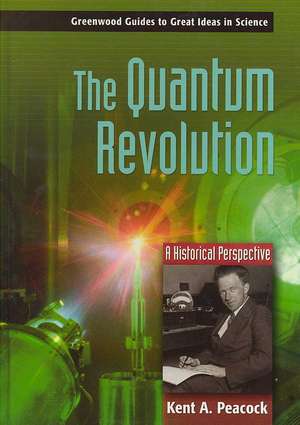The Quantum Revolution: A Historical Perspective: Greenwood Guides to Great Ideas in Science
Autor Kent A. Peacocken Limba Engleză Hardback – 29 dec 2007 – vârsta până la 17 ani
Preț: 277.82 lei
Preț vechi: 586.75 lei
-53% Nou
Puncte Express: 417
Preț estimativ în valută:
53.16€ • 55.40$ • 44.02£
53.16€ • 55.40$ • 44.02£
Carte tipărită la comandă
Livrare economică 03-17 aprilie
Preluare comenzi: 021 569.72.76
Specificații
ISBN-13: 9780313334481
ISBN-10: 031333448X
Pagini: 240
Ilustrații: 11 b&w illustrations, 26 line drawings
Dimensiuni: 178 x 254 x 24 mm
Greutate: 0.66 kg
Editura: Bloomsbury Publishing
Colecția Greenwood
Seria Greenwood Guides to Great Ideas in Science
Locul publicării:New York, United States
ISBN-10: 031333448X
Pagini: 240
Ilustrații: 11 b&w illustrations, 26 line drawings
Dimensiuni: 178 x 254 x 24 mm
Greutate: 0.66 kg
Editura: Bloomsbury Publishing
Colecția Greenwood
Seria Greenwood Guides to Great Ideas in Science
Locul publicării:New York, United States
Notă biografică
Kent A. Peacock is Professor of Philosophy at the University of Lethbridge, in Alberta, Canada. Peacock received his Ph.D from the University of Toronto and has also taught at the University of Western Ontario. He has published in philsophy of science, metaphsics of time, and ecological philosophy, and he spends much of his time trying to understand why it is still not obvious that quantum mechanics should be true.
Recenzii
This delightful volume should be on the shelf of just about every undergraduate library; hopefull, students will find it and give it a read. A well-constructed index is included. Recommended. General readers; lower- and upper-division undergraduates.
There are appealing and relevant sidelights on the lives and relationships of the physicists and on the technologies that depend on our advances in understanding. The long lasting debates on the foundations and interpretations of quantum mechanics are discussed in deatil; the arguments of Einstein, Bohr, Schrodinger, von Neumann, Bohm, Bell, and many others; the problems of entanglement; and the possibility of nonlocality. For those who are interested, this discussion is an outstanding feature of the book. The time line, glossary, recommendations for further reading, and list of references are valuable additions.
The Quantum Revolution can serve as a resource to guide students through the work that was done by scientists such as Einstein, Bohr, Heisenberg, Pauli, Dirac, Schrodinger, and others..[E]specially recommended to those who are interested in researching the atomic theory, the development of nuclear weapons, and nuclear physics.
The book is designed for the reader who has an interest in quantum theory and its history. The text does not contain numerous mathematical formulas, which makes it easier for the nontechnical person to understand. .This book is recommended for public and college libraries.
There are appealing and relevant sidelights on the lives and relationships of the physicists and on the technologies that depend on our advances in understanding. The long lasting debates on the foundations and interpretations of quantum mechanics are discussed in deatil; the arguments of Einstein, Bohr, Schrodinger, von Neumann, Bohm, Bell, and many others; the problems of entanglement; and the possibility of nonlocality. For those who are interested, this discussion is an outstanding feature of the book. The time line, glossary, recommendations for further reading, and list of references are valuable additions.
The Quantum Revolution can serve as a resource to guide students through the work that was done by scientists such as Einstein, Bohr, Heisenberg, Pauli, Dirac, Schrodinger, and others..[E]specially recommended to those who are interested in researching the atomic theory, the development of nuclear weapons, and nuclear physics.
The book is designed for the reader who has an interest in quantum theory and its history. The text does not contain numerous mathematical formulas, which makes it easier for the nontechnical person to understand. .This book is recommended for public and college libraries.








